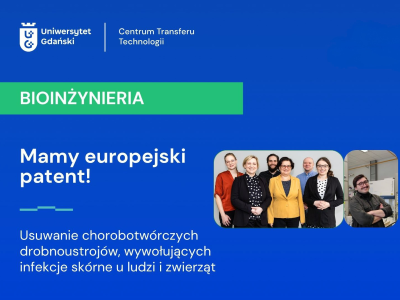
In recent years, there has been a growing demand for effective and safe methods of eliminating microorganisms that cause skin infections in humans and animals. Researchers from the Intercollegiate Faculty of Biotechnology UG and MUG, in collaboration with scientists from the Wrocław University of Technology, have developed an innovative solution for the effective removal of microorganisms from flat surfaces using cold atmospheric plasma. The invention, which has been granted protection by the European Patent Office, can be used for effective surface sterilisation in a variety of spaces, including hospitals, laboratories and breeding facilities.
The solution patented by the European Patent Office, developed by scientists from the University of Gdańsk and Wrocław University of Technology, is entitled ‘Method for eradicating pathogenic microorganisms from flat surfaces’. It enables highly efficient removal of microorganisms responsible for skin infections in humans and animals, such as Staphylococcus aureus, Staphylococcus epidermidis, Candida albicans and Dermatophilus congolensis. Sterilisation is carried out using an innovative system that utilises cold atmospheric plasma (CAPP), generated in the form of dielectric barrier discharge (DBD) in the form of a gas stream.
‘Slow-healing wounds are a source of acute or chronic pain, which significantly contributes to a lower quality of life and a poorer prognosis for farm animals infected with multidrug-resistant bacterial strains,’ explains dr hab. inż. Wojciech Śledź. ‘Bacterial strains isolated from animal wounds often belong to species that also infect patients in hospital settings. It is worth emphasising the particular virulence and difficulty in combating pathogens obtained from hospital environments, as well as the limited effectiveness of conventional antibiotic therapies, associated with the widespread phenomenon of multidrug resistance among microorganisms. The invention developed by our team is intended to respond to the need for effective elimination of microorganisms from surfaces where they are often found and constitute a source of infection.’
The research was carried out by the following scientific teams:
- from the University of Gdańsk: dr Agata Motyka-Pomagruk, dr hab. inż. Wojciech Śledź, dr Weronika Babińska-Wensierska, prof. dr hab. Ewa Łojkowska, Michał Prusiński, mgr, Jakub Orłowski, mgr
- from the Wrocław University of Technology: dr hab. inż. Anna Dzimitrowicz, prof. PWr, prof. dr hab. inż. Paweł Pohl, dr hab. inż. Piotr Jamróz, prof. PWr.
‘Since 2015, we have been cooperating with scientists from Wrocław University of Science and Technology on the effective control of microorganisms using cold atmospheric plasma. The barrier discharges used in this invention are a source of reactive forms of oxygen and nitrogen, free electrons and UV radiation with strong antimicrobial properties. It is worth noting the limited possibility of microorganisms becoming resistant to sterilisation methods based on such complex mechanisms,’ explains dr Agata Motyka-Pomagruk.
The solution has already been tested in laboratory conditions. The European patent obtained opens up the possibility of wider implementation of the described technology. Currently, companies interested in commercialising the technology are being sought.
The scientists' invention, ‘Method for eradicating pathogenic microorganisms from flat surfaces,’ has also been submitted to the Patent Office in Poland, has undergone a verification procedure, and has received patent protection.
The intellectual property protection processes in proceedings before the European and Polish patent offices were coordinated by specialists from the Technology Transfer Office at the University of Gdańsk.
